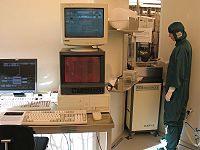Specific Process Knowledge/Etch/RIE (Reactive Ion Etch): Difference between revisions
No edit summary |
|||
| Line 8: | Line 8: | ||
*[[Specific Process Knowledge/Etch/Etching of Silicon Oxide/SiO2 etch using RIE1 or RIE2|Etch of Silicon Oxide using RIE]] | *[[Specific Process Knowledge/Etch/Etching of Silicon Oxide/SiO2 etch using RIE1 or RIE2|Etch of Silicon Oxide using RIE]] | ||
*[[Specific Process Knowledge/Etch/Etching of Silicon Nitride/Etch of Silicon Nitride using RIE|Etch of Silicon Nitride using RIE]] | *[[Specific Process Knowledge/Etch/Etching of Silicon Nitride/Etch of Silicon Nitride using RIE|Etch of Silicon Nitride using RIE]] | ||
<br clear="all" /> | |||
==A rough overview of the performance of PECVD thin films and some process related parameters== | |||
{| border="2" cellspacing="0" cellpadding="10" | |||
|- | |||
!style="background:silver; color:black;" align="left"|Purpose | |||
|style="background:LightGrey; color:black"|Deposition of dielectrica ||style="background:WhiteSmoke; color:black"| | |||
*Silicon oxide | |||
*Silicon nitride | |||
*Silicon oxynitride | |||
*PBSG (Phosphorous Boron doped Silica Glass) | |||
*Silicon oxide doped with Germanium | |||
|- | |||
!style="background:silver; color:black" align="left"|Performance | |||
|style="background:LightGrey; color:black"|Film thickness||style="background:WhiteSmoke; color:black"| | |||
*~10nm - 30µm | |||
|- | |||
|style="background:silver; color:black" |.||style="background:LightGrey; color:black"|Index of refraction||style="background:WhiteSmoke; color:black"| | |||
*~1.4-2.1 | |||
|- | |||
|style="background:silver; color:black"|.||style="background:LightGrey; color:black"|Step coverage | |||
|style="background:WhiteSmoke; color:black"| | |||
*In general: Not so good | |||
*PBSG: Floats at 1000<sup>o</sup>C | |||
|- | |||
|style="background:silver; color:black"|.||style="background:LightGrey; color:black"|Film quality | |||
|style="background:WhiteSmoke; color:black"| | |||
*Not so dense film | |||
*Hydrogen will be incorporated in the films | |||
|- | |||
!style="background:silver; color:black" align="left"|Process parameter range | |||
|style="background:LightGrey; color:black"|Process Temperature | |||
|style="background:WhiteSmoke; color:black"| | |||
*300 <sup>o</sup>C | |||
|- | |||
|style="background:silver; color:black"|.||style="background:LightGrey; color:black"|Process pressure | |||
|style="background:WhiteSmoke; color:black"| | |||
*~200-900 mTorr | |||
|- | |||
|style="background:silver; color:black"|.||style="background:LightGrey; color:black"|Gas flows | |||
|style="background:WhiteSmoke; color:black"| | |||
*SiH<math>_4</math>:0-60 sccm | |||
*N<math>_2</math>O:0-3000 sccm | |||
*NH<math>_3</math>:0-1000 sccm | |||
*N<math>_2</math>:0-3000 sccm | |||
*GeH<math>_4</math>:0-6.00 sccm | |||
*5%PH<math>_3</math>:0-99 sccm | |||
*5%B<math>_2</math>H<math>_6</math>:0-1000 sccm | |||
|- | |||
!style="background:silver; color:black" align="left"|Substrates | |||
|style="background:LightGrey; color:black"|Batch size | |||
|style="background:WhiteSmoke; color:black"| | |||
*1-3 4" wafer per run | |||
*1 6" wafer per run | |||
*Or several smaler pieces | |||
*Deposition on one side of the substrate | |||
|- | |||
|style="background:silver; color:black"|.|| style="background:LightGrey; color:black"|Substrate material allowed | |||
|style="background:WhiteSmoke; color:black"| | |||
*Silicon wafers | |||
**with layers of silicon oxide or silicon (oxy)nitride | |||
*Quartz wafers | |||
|- | |||
|style="background:silver; color:black"|.|| style="background:LightGrey; color:black"|Material allowed on the substrate | |||
|style="background:WhiteSmoke; color:black"| | |||
*Aluminium | |||
*All metals < 5% of the substrate coverage (ONLY PECVD3!) | |||
|- | |||
|} | |||
Revision as of 11:29, 5 December 2007
Etching using the dry etch technique RIE (Reactive Ion Etch)
At Danchip we have three RIE's. Two (RIE1 and RIE2) for etching silicon based materials (silicon, silicon oxide, sillicon nitride) and one (III-V RIE) for etching III-V materials (is discussed under III-V processing). The hardware of RIE1 and RIE2 is very similar but you cannot count on that identical recipes on RIE1 and RIE2 perform exactly the same. In addition to that the main difference between RIE1 and RIE2 is the cleanness of the two equipment. In rough terms RIE1 is the clean system and the RIE2 is the dirty system. This means that in RIE2 opposed to RIE1 it is allowed have small amounts of metals exposed to the plasma. Look in the manuals for RIE1 and RIE2 to read the details for this difference (you can find the manuals in LabManager [1]).
Process information
| Purpose | Deposition of dielectrica |
|
|---|---|---|
| Performance | Film thickness |
|
| . | Index of refraction |
|
| . | Step coverage |
|
| . | Film quality |
|
| Process parameter range | Process Temperature |
|
| . | Process pressure |
|
| . | Gas flows |
|
| Substrates | Batch size |
|
| . | Substrate material allowed |
|
| . | Material allowed on the substrate |
|





